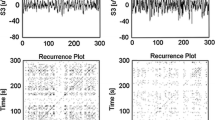Abstract
The objective of the study was to perform serial magnetomyographic examinations in order to detect changes in synchrony characteristics of myometrial electrophysiological activity as women approach labor. Of the total of 56 patients recruited, the results of 149 examinations from 29 patients were included in the analysis. The global synchrony across each sensor spread over the abdomen was computed and quantified as synchronization index. The mean and the median value of the global synchrony were computed and correlated with time to active labor from the last recording. Overall, synchrony increased as the patient approached active labor (P = .035). Furthermore, mean synchronization index increased twice as fast in the nonnulliparous group compared to the nulliparous group (P = .039). The changes in synchrony of uterine electrophysiological activity near term could aid in prediction of labor.
Similar content being viewed by others
References
Zerhouni EA. A report on “Prematurity Research at the NIH” 2008. http://www.nichd.nih.gov/publications/pubs/Documents/nih_prematurity_research_2008.pdf. Published Feb 2008. Accessed October 6, 2014.
Morrison J, Martin J, Martin R, Gookin K, Wiser W. Prevention of preterm birth by ambulatory assessment of uterine activity: a randomized study. Am J Obstet Gynecol. 1987;156(3):536–537.
McCormick MC. The contribution of low birth weight to infant mortality and childhood morbidity. N Engl J Med. 1985;312(2):82–90.
Reichmann JP. Home uterine activity monitoring: the role of medical evidence. Obstet Gynecol. 2008;112(2 pt 1):325–327.
Devedeux D, Marque C, Mansour S, Germain G, Duchene J. Uterine electromyography: a critical review. Am J Obstet Gynecol. 1993;169(6):1636–1653.
Kao CY. Long-term observations of spontaneous electrical activity of the uterine smooth muscle. Am J Physiol. 1959;196(2):343–350.
Marshall JM. Regulation of activity in uterine smooth muscle. Physiol Rev Suppl. 1962;5:213–227.
Young RC. Myocytes, myometrium, and uterine contractions. Ann N Y Acad Sci. 2007;1101:72–84.
Lammers WJ. The electrical activities of the uterus during pregnancy. Reprod Sci. 2013;20(2):182–189.
Miller SM, Garfield RE, Daniel EE. Improved propagation in myometrium associated with gap junctions during parturition. Am J Physiol. 1989;256(1 pt 1):C130–C141.
Csapo AI, Takeda H. Electrical activity of the parturient human uterus. Nature. 1963;200:680–682.
Csapo AI, Takeda H. Effect of progesterone on the electric activity and intrauterine pressure of pregnant and parturient rabbits. Am J Obstet Gynecol. 1965;91:221–231.
Verhoeff A, Garfield RE, Ramondt J, Wallenburg HC. Electrical and mechanical uterine activity and gap junctions in peripartal sheep. Am J Obstet Gynecol. 1985;153(4):447–454.
Wolfs GM, van Leeuwen M. Electromyographic observations on the human uterus during labour. Acta Obstet Gynecol Scand Suppl. 1979;90:1–61.
Eswaran H, Preissl H, Wilson JD, Murphy P, Lowery CL. First magnetomyographic recordings of the uterine activity with spatial–temporal resolution using a 151 channel sensor array. Am J Obstet Gynecol. 2002;187(1):145–151.
Eswaran H, Preissl H, Wilson JD, Murphy P, Lowery CL. Prediction of labor it term and preterm pregnancies using non-invasive magnetomyographic recordings of uterine contractions. Am J Obstet Gynecol. 2004;190(6):1598–1602.
Eswaran H, Govindan RB, Furdea A, Murphy P, Lowery CL, Preissl H. Extraction, quantification and characterization of uterine magnetomyographic activity—a proof of concept case study. Eur J Obstet Gynecol Rep Biol. 2009;144(suppl 1): S96–S100.
Furdea A, Eswaran H, Wilson JD, Preissl H, Lowery CL, Govindan RB. Magnetomyographic recording and identification of uterine contractions using Hilbert-wavelet transforms. Physiol Meas. 2009;30(10):1051–1060.
Swearingen CJ, Tilley BC, Adams RJ, et al. Application of beta regression to analyze ischemic stroke volume in NINDS rt-PA clinical trials. Neuroepidemiology. 2011;37(2):73–82.
Taggart MJ, Blanks A, Kharche S, Holden A, Wang B, Zhang H. Towards understanding the myometrial physiome: approaches for the construction of a virtual physiological uterus. BMC Pregnancy Childbirth. 2007;7(suppl 1):S3.
Ramon C, Preissl H, Wilson JD, Murphy P, Lowery CL, Eswaran H. Synchronization analysis of uterine magnetic activity during contractions. BioMed Eng Online. 2005;4:55–59.
Garfield RE, Blennerhassett MG, Miller SM. Control of myometrial contractility: role and regulation of gap junctions. Oxf Rev Reprod Biol. 1988;10:436–490.
Garfield RE, Maner WL, MacKay LB, Schlembach D, Saade GR. Comparing uterine electromyography activity of antepartum patients versus term labor patients. Am J Obstet Gynecol. 2005; 193(1):23–29.
Garfield RE, Maner WL. Physiology and electrical activity of uterine contractions. Semin Cell Dev Biol. 2007;18(3):289–295.
Lucovnik M, Maner WL, Chambliss LR, et al. Noninvasive uterine electromyography for prediction of preterm delivery. Am J Obstet Gynecol. 2011;204(3):228.e1–e10.
Jiang W, Li G, Lin L. Uterine electromyogram topography to represent synchronization of uterine contractions. Int J Gynaecol Obstet. 2007;97(2): 120–124.
Neal JL, Lowe NK, Ahijevych KL, Patrick TE, Cabbage LA, Corwin EJ. “Active labor” duration and dilation rates among low-risk, nulliparous women with spontaneous labor onset: a systematic review. J Midwifery Womens Health. 2010;55(4):308–318.
Hilliard AM, Chauhan SP, Zhao Y, Rankins NC. Effect of obesity on length of labor in nulliparous women. Am J Perinatol. 2012; 29(2): 127–132.
Denison FC, Price J, Graham C, Wild S, Liston WA. Maternal obesity, length of gestation, risk of postdates pregnancy and spontaneous onset of labour at term. BJOG. 2008;115(6):720–725.
Margriples U, Kershaw TS, Rising SS, Westdahl C, Ickovics JR. The effects of obesity and weight gain in young women on obstetric outcomes. Am J Perinatol. 2009;26(5):365–371.
Beyer DA, Amari F, Ludders DW, Diedrich K, Weichert J. Obesity decreases the chance to deliver spontaneously. Arch Gynecol Obstet. 2011;283(5):981–988.
Author information
Authors and Affiliations
Corresponding author
Rights and permissions
About this article
Cite this article
Govindan, R.B., Siegel, E., Mckelvey, S. et al. Tracking the Changes in Synchrony of the Electrophysiological Activity as the Uterus Approaches Labor Using Magnetomyographic Technique. Reprod. Sci. 22, 595–601 (2015). https://doi.org/10.1177/1933719114556484
Published:
Issue Date:
DOI: https://doi.org/10.1177/1933719114556484




